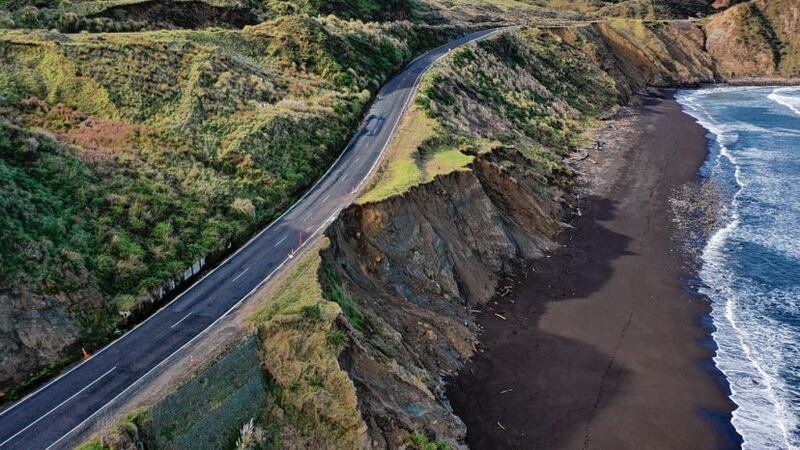A section of Māhia's Nuhaka Opoutama Road dropped away earlier this year following heavy rainfall. The council say climate change appears to be exacerbating erosion in the area. Photo: Ben Cowper / Gisborne Herald
The coastal road providing the main access to Māhia Peninsula is slowly dropping into the sea, leaving one concerned resident wondering what plan of action is to be taken.
Nuhaka Opoutama Road connects Hawke's Bay/Wairoa (from the south) and Gisborne (north) with Māhia - a peninsula home to 1100 people which burgeons with holidaymakers over summer.
But road cones have become a familiar sight on the road, where coastal erosion has created slumps and drop-offs, forcing drivers into a single lane at some sections.
At one point, traffic comes within a few metres of a cliff's edge, where the road's shoulder has given away and crumbled onto the beach below.
For Mahia resident Merv Goodley, who has lived in the area for 39 years, seeing the coastline drop into the sea has become normal.
"They've just got to put a new road through ... just shift it all in," he said. "I don't think they can cut inland over the other side of the hill.
"It's stuffed. Beach Loop proves that. It's all dropping into the sea."
Part of the problem was the papa the roads were built on, he said, referring to the East Coast's soft mudstone rock that is prone to crumbling.
Goodley feared Nuhaka Opoutama Road could be destined for the same fate as Beach Loop - an area between Māhia and Gisborne - where the landscape changed significantly after a landslide in November last year.
The area had particular interest to him because of its significance as part of the Napier-Gisborne railroad, which ceased operation in 2012 following severe weather.
In May, the railroad was thrust back into the spotlight when it was revealed Gisborne District Council, Hawke's Bay Regional Council and Wairoa District Council had spent $60,000 on a report looking into a potential reopening.
The Napier-Wairoa section reopened in 2019 but the stretch to Gisborne has remained closed.
Goodley feared holding on to hope for rail reinstatement had come at the expense of Nuhaka Opoutama Road.
At a section before Opoutama, the road has been reduced to a single lane adjacent to the now-unused railway track.
Wairoa District Council told Local Democracy Reporting it was working with KiwiRail, which had agreed to move the rail inland at the blowhole site to allow for shifting the road over.
The council is aware of two new dropouts - one along Blacks Beach, where the road has been reduced to a single lane, and one along Mahia East Coast Road.
Wairoa District Council chief executive Kitea Tipuna said both occurred during the heavy rainfall events of March and April.
"Climate change appears to be exacerbating coastal erosion," Tipuna said.
Coastal erosion and Māhia connectivity had been identified as key areas of the council's land transport activity management plan for 2021-2031, he said.
The Nuhaka Opoutama Road was recognised as a key project in the Hawke's Bay Regional Transport Plan, and the council was also working with external funders to secure 25 percent of an estimated $8.4 million required to strengthen the coastline. The remainder would be funded by Waka Kotahi NZ Transport Agency.
In 2020, a business case funded by the Provincial Growth Fund found protecting the existing Nuhaka Opoutama Road, including the blowhole dropout, was the best way forward.


